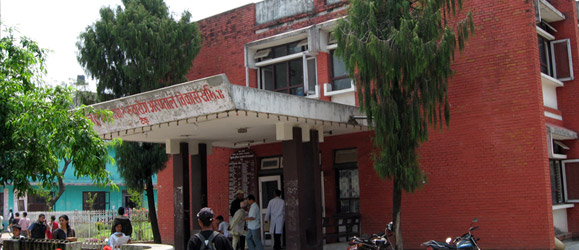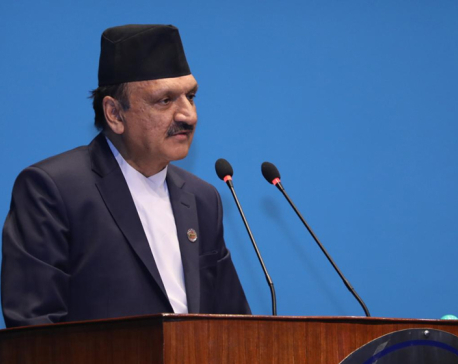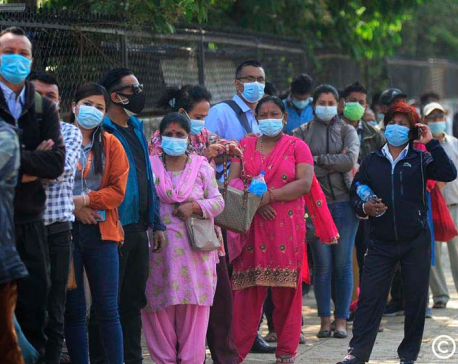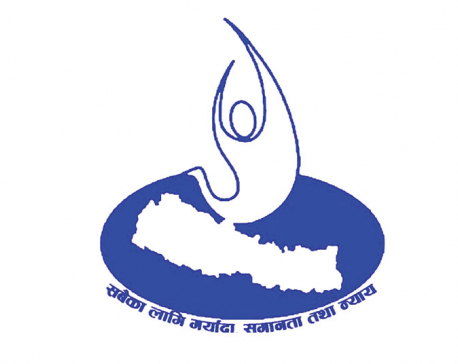
OR
Teku hospital’s excellent performance during COVID-19 pandemic
Published On: April 25, 2021 03:34 PM NPT By: SHREE RAM SUBEDI

“If anyone suspected the COVID-19 infection, they would come to Teku hospital and even other hospitals would refer people to this hospital for consultation,” recalls Sher Bahadur Pun, Clinical Research Unit Coordinator at Sukraraj Tropical and Infectious Disease Hospital. According to him, in the initial stage, Kathmandu was shocked after a family that travelled from the UK tested positive for COVID-19. The next day, people lined up at Teku hospital to get tested for COVID-19.
“Even though it is a government hospital, the health workers of this hospital worked day and night,” said Kamala Gaire, who runs a small tea shop in front of the main gate of Sukraraj Tropical and Infectious Disease Hospital (STIDH). She has been running the shop for the past five years and has served thousands of people who visited the hospital for PCR tests and COVID-19 treatment.
“I have heard people coming for tea at my shop praise this hospital. This hospital is better than other hospitals,” she added. As Gaire mentioned, STIDH is the most talked-about hospital since the onset of the COVID-19 pandemic.
The hospital has done admirable work in terms of treatment of the first corona infection in Nepal, PCR testing, setting up a modern oxygen plant, installment of filters, making personal protective equipment available and keeping the morale of health workers high.
Although the work done by this hospital is naturally expected as it is a specialized hospital for the control of communicable diseases, the management of technical and human resources in difficult pandemic conditions is not an easy task.
The hospital, which was established 88 years ago as a hospice for the treatment of cholera on the premises of the ropeway terminal at Pachali in Teku in 1990 BS, the year of the first recorded major earthquake in Nepal, was shifted to its present location in 2007 BS.
The building of the hospital, which was converted into an epidemic disease management unit under Bir Hospital in 2019 BS, was renovated in the same year. It was redeveloped as an epidemiological hospital by separating it from Bir Hospital in 2034 BS and renamed as Teku Hospital in 2042 BS.
The hospital was renamed as ‘Sukraraj Tropical and Infectious Disease Hospital’ on February 11, 1997. Since its inception, the hospital has been providing various health services including treatment of leprosy, rabies, HIV and AIDS, malaria, kala-azar, tetanus and snake bites.
The COVID-19 pandemic started spreading around the world in 2019 starting from Wuhan of China. Nepal also got affected by the pandemic. In the third week of February, 2020, a 32-year-old man was admitted to Teku hospital with symptoms similar to the coronavirus. The patient, who had symptoms of common cold and respiratory problems, was discharged from the hospital after his health improved.
The swab of the person was sent to Hong Kong for a test as he was studying in Wuhan, China, where the virus is believed to have originated. This was the first official case of COVID-19 in Nepal.
The health workers involved in the treatment of the young man at Teku Hospital were treating the patient without wearing the required personal protective equipment (PPE). Fortunately, the friends and relatives who were in contact with the patient did not show any symptoms of COVID-19. About two months later, the second case was confirmed, in a student who had returned from France.
Since then, the number of infected people in Nepal has been increasing steadily. While COVID-19 was killing thousands of people in China, it was natural for Nepal to panic. The pandemic had spread from China to various countries in Europe, including Italy. Those who returned from China were treated differently in Nepal. During that period, Teku Hospital consulted hundreds of returnees from China.
“If anyone suspected COVID-19 infection, they would come to Teku Hospital and even other hospitals would refer people to this hospital for consultation,” recalls Sher Bahadur Pun, Clinical Research Unit Coordinator at Sukraraj Tropical and Infectious Disease Hospital. According to him, in the initial phase, Kathmandu was shocked after a family that travelled from the UK tested positive for COVID-19. The next day, people lined up at Teku hospital to get tested for COVID-19. At that time, the number of people who came for the test was more due to fear than the actual spread of the coronavirus.
Other hospitals used to refer people to Teku hospital if they showed any symptoms of cold. As the only communicable disease hospital in the country, Teku hospital was ready to physically and mentally counsel such infected people and treat them, if necessary.
The hospital was almost ready to fight the pandemic in terms of physical and manpower resources by adding intensive care units (ICUs) and ventilators. Before COVID-19 hit the country, Teku hospital did not have ICUs. Currently, there are 22 patients in the ICU of the hospital. Before the pandemic, there were only two ventilators, but during this period, six more ventilators were added, taking the number to eight.
There was a three-month long lockdown from March 24 last year that prevented the spread of the coronavirus infection in the capital. But after the lockdown, the number of infected people in Kathmandu skyrocketed after the more infected people started coming to Nepal from other hotspots in India and other countries. As asymptomatic people did not need to be tested, the asymptomatic ‘silent coronavirus’ started entering and spreading in Kathmandu.
The chief consultant of the hospital and coordinator of COVID-19 treatment, Dr Anup Bastola says that while the doctors at other hospitals are treating Covid patients from outside the room or from distance, Teku hospital is providing medical services to the patients closely.
“Not just on medicine and treatment, we have also focused on the psychological side of the patients,” Dr Bastola said, “We have prioritised the holistic approach, including emotional connection, continuous communication and counseling the patient.” The hospital had provided free WiFi and mobile phones to the patients who did not have one.
According to Dr Sagar Rajbhandari, who has been serving as the director of the hospital since February 2020, the hospital treated more than 1,000 corona patients by mid-2077 BS. Some 51 people died during the treatment. Similarly, more than five dozen employees were infected during the treatment, but they returned to work within a week of being infected. According to Dr Rajbhandari, the hospital has treated two to 55 people daily in the last one year.
Initially, the corona testing facility was only available at the National Public Health Laboratory, but the hospital set up a PCR testing laboratory on May 15, 2020. Dr Rajbhanadari considers the establishment of the laboratory as an important achievement. As of mid-April 2021, the laboratory has conducted the PCR tests of 58,477 people, out of which 8,391 tested positive for the virus.
Oxygen is important for COVID-19 patients as they have respiratory problems. The hospital set up a liquid oxygen plant during last year’s lockdown and installed oxygen pipes in all 55 beds of the hospital.
Hepa filters were installed to prevent the spread of bacteria from one room of the ICU to another. Dr Rajbhandari states that the hospital is the first in Nepal to treat corona with Remdesivir medicine and plasma therapy.
The hospital had provided 50 to 100 percent incentives, COVID and health insurance to the health workers and employees working in the treatment of COVID-19, and arranged for those who could not go home to stay at hotels. The hospital continued the treatment of dog bites and HIV-AIDS even during the pandemic.
Meanwhile, the hospital has been treating one-third of the total HIV positive population in Nepal and treating 250 to 400 people bitten by dogs every day. Similarly, this hospital is at the forefront in the treatment of snake bites, kala-azar, dengue, tuberculosis, malaria and other health problems in the country.
In 2076 BS, for the first time in the history of Nepal, there was a nationwide dengue epidemic and a large number of people were infected in Kathmandu. At that time, this hospital played a leading role in dengue testing, treatment and counseling.
“With 279 hospital staffers working together, it has become easier to deal with the crisis,” said Dr Rajbhandari. Having trained health workers in the treatment of communicable diseases, accurate information and counseling services about the disease, adequate supply of PPE during treatment and maintaining high morale of all the staffers is an important aspect of the hospital. The government provided Rs 125 million to the hospital during the pandemic.
Dr Rajbhandari, who is about to retire from government service in a few months, sees the need to expand the existing 60-bed hospital to a 300-bed hospital to maintain the historical significance of the hospital.
“There is no need to relocate the hospital. This hospital can be expanded by constructing a multi-storey building at the same place,” he says. Likewise, he also argues that the hospital could provide a master's degree in Tropical Infectious Diseases and make it one of the strongest hospitals in South Asia in infectious disease research by advancing training and research.
You May Like This

Govt to expand capacity of Teku Hospital to 300 beds
KATHMANDU, May 29: The government is planning to upgrade the Sukraraj Tropical and Infectious Disease Hospital, commonly known as the... Read More...

Teku Hospital resumes COVID-19 vaccination from today
KATHMANDU, Jan 25: The Sukraraj Tropical and Infectious Disease Hospital, Teku is resuming the vaccination campaign from today. ... Read More...

NHRC urges govt to test and treat COVID-19 patients for free
KATHMANDU, Oct 20: The National Human Rights Commission (NHRC) has urged the government to provide free test and treatment to... Read More...




Just In
- Govt receives 1,658 proposals for startup loans; Minimum of 50 points required for eligibility
- Unified Socialist leader Sodari appointed Sudurpaschim CM
- One Nepali dies in UAE flood
- Madhesh Province CM Yadav expands cabinet
- 12-hour OPD service at Damauli Hospital from Thursday
- Lawmaker Dr Sharma provides Rs 2 million to children's hospital
- BFIs' lending to private sector increases by only 4.3 percent to Rs 5.087 trillion in first eight months of current FY
- NEPSE nosedives 19.56 points; daily turnover falls to Rs 2.09 billion















Leave A Comment